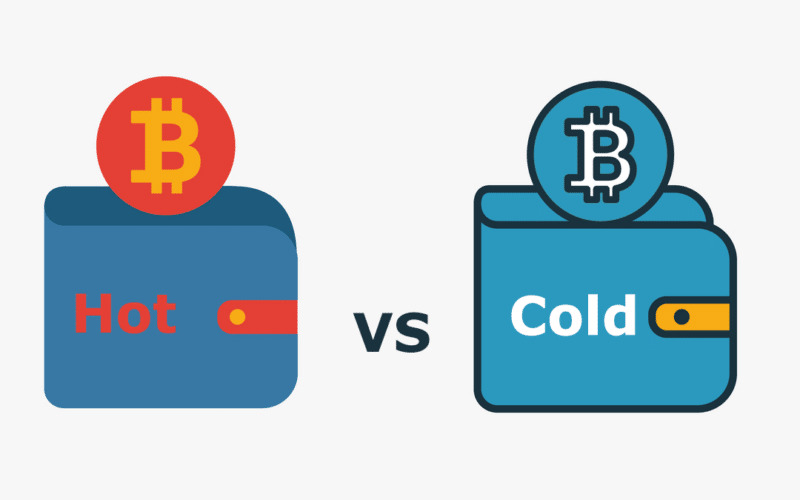What is a hot and cold wallet in cryptocurrencies? In this article, you’ll learn the differences between the two.
Cryptocurrencies have revolutionized how we interact with money. Yet, unlike fiat currencies, users need to understand a few things about using such coins, one of which is their storage.
Technically, there are three main types of wallets; hot (online-based), cold (hardware-based), and paper. However, the paper version is rarely used since it’s less reliable. Therefore, the most common types that users will encounter are hot and cold, with hot being the more popular version because of its convenience.
Knowing the type of wallet one owns is an essential observation considering the delicate nature of coins. Once cryptocurrencies are lost in any way, they are nearly impossible to recover.
Also, knowing the mechanism of wallets is integral to understanding how transactions work in general with exchanges and wallet providers. Let’s dive deeper into how these work, the differences between hot and cold, and the pros and cons.
How do cryptocurrency wallets work?
One crucial thing to note about crypto wallets is they don’t technically store any coins. Rather, a wallet is merely a tool to interact with a particular blockchain holding the actual tokens.
Wallets are a link to this specific location and keep the public and private keys. A public key is linked to a distributed ledger and is typically an alphanumeric address a user publicly shares to receive crypto.
Someone with another person’s public key or address cannot access their holdings; they can only transfer funds to it. A private key proves ownership of the coins in question and is necessary to unlock a user’s holdings.
It can take many different incredibly cryptic forms, such as a 256-character binary code, 64-digit hexadecimal code, mnemonic phrase, or QR code. From a user perspective, the private keys are particularly sensitive and should never be shared with anyone.
If the trader uses a centralized/custodial exchange or hot wallet service, they don’t store the private keys themselves. Contrastingly, with a decentralized/non-custodial exchange or cold wallet facility, this responsibility largely shifts to the user.
In most cases, a decentralized exchange or cold wallet service provides a seed phrase as backup, which is much easier to store but is also incredibly sensitive because once lost or stolen, it makes the recovery of coins nearly unfeasible.
So, what is a hot wallet?
A hot wallet is connected to the internet and is commonly used by numerous centralized exchanges like Binance, Coinbase, Gemini, and services like Trezor, Ledger, etc. This type of storage is the quickest to set up as it mainly involves creating an account and only needs the internet for access.
Other forms of hot wallets are web, mobile, and desktop applications installed on their respective mediums. As briefly mentioned, the exchange or wallet service provides the public address to the client to receive funds and takes custody of the private keys.
Hot wallets provide the advantage of quick accessibility to someone’s crypto and are useful for those transacting frequently. However, the main drawback is this storage option is susceptible to hacks.
Should a hacker access a hot wallet, they can steal all cryptocurrencies linked to their private keys. Many exchanges in the past who have been victims of massive hacking incidents kept their clients’ coins using such storage, which made them vulnerable to hefty security breaches.
Nowadays, all reputable exchanges typically keep only a tiny portion of their users’ crypto in hot and store the rest in the cold. Some ordinary users have also followed suit as well for protection reasons.
What is a cold wallet?
A cold wallet is, in no way, connected to the internet, instead of relying on a physical device to save the keys offline. As a result, this storage option is resistant to hacking attempts and is considered a secure alternative compared to hot.
Cold wallets are suitable for those holding their coins long-term or with an enormous value of cryptocurrencies who don’t need immediate access to their holdings. This type of storage comes in the form of hardware, namely a USB (the most common choice), hard drive, or compact disc.
These devices rely on a random number generator on a smartcard allowing users to read and access their public and private keys off the internet. Although cold wallets are technically safer and protected, they aren’t particularly user-friendly and make accessing tokens cumbersome.
Fortunately, with a few advancements, some decentralized exchanges and external wallet facilities enable users to connect these to a browser application while still maintaining offline security.
Also, since the responsibility of the private keys lies solely with the owner, extra safekeeping measures need to be in place. Lastly, users need to ensure the firmware execution is properly conducted when configuring the wallet.
Nonetheless, cold wallets are not broadcast to the internet, making them incredibly challenging to hack.
Final word
Anyone receiving or buying any cryptocurrency must ask themselves whether to consider a hot or cold wallet. As this article has briefly explored, hot wallets are connected to the web, allowing for convenience and quick approachability. Yet, the main problem is their susceptibility to online attacks.
On the other hand, a cold wallet is not linked to the internet, making it more resistant to such malware but also less convenient to access. Having both of these alternatives presents a trade-off between effortlessness and security.
A common practice with serious crypto holders, which was briefly explored in a previous section, is using both wallets. Many tend to hold a small percentage of their holdings in a hot wallet for everyday or regular transactions and keep the rest in cold storage.
An emerging trend is the utilization of a second phone functioning as a cold wallet. Here, traders connect this phone (the cold wallet) to their primary phone (the hot wallet) when transferring funds.
Regardless of the technique, someone might consider using, crypto users should know about the risks and advantages of both choices.
Read also: Top 5 Cold Storage Crypto Wallets







